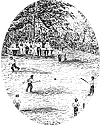In Mobile in 1860
| Date of Game | 1860 date is inferred |
|---|---|
| Location | Mobile, AL, United States |
| Modern Address | |
| Field | Add Field Page Spring Hill College |
| Home Team | Add Club Page |
| Away Team | Add Club Page |
| Score | |
| Game Number | |
| Innings | |
| Number of Players | |
| Game Officials | |
| NY Rules | Unknown |
| Tags | |
| Description | Alabama was reportedly the original source of Cuban baseball. "Baseball thus appeared in Cuba as early as the end of the U.S. Civil War and was thriving there only a few years later. Bats, balls, leather gloves, and rules for playing the new North American pastime were first carried to Havana by a pair of brothers, Nemesio and Ernesto Guillo . . . when the teenagers returned from a half-decade of high schooling at Alabama's Spring Hill College in 1864. Within mere days they were organizing rudimentary contests . . . in downtown Havana. Less than four years later, the Guillo brothers . . . had formed the Havana Base Ball Club." Spring Hill College is in western Mobile AL, which is on the Gulf of Mexico and near the Mississippi border. It is a Jesuit institution and was established in 1830. Mobile's population was about 29,000 in 1860, making it the 4th largest CSA city and the 27th largest in the US. Mobile's cotton exports were second only to New Orleans in the 1840s.
OPEN ISSUE [2]: Civil War historian Bruce Allardice points out that ballplaying at Spring Hill may have occurred in 1861 or so, rather than in 1864, as most southern academies lost both their students and faculties to the War and closed for its duration. Also, that Spring Hill College was a favorite place for New Orleans Catholics to send their sons, and as we know baseball was being played in New Orleans prior to 1860. Note. On 10/8/2022, ERalph Poore of Boise ID sent the following information: "Spring Hill College remained open throughout the Civil War. In 1861, Fr. Francis Gautrelet, S.J., visited Confederate president Jefferson Davis and asked that recruitment of lay faculty and students be stopped. Many students were too young to enlist, and enrollment increased in 1864 with families hoping to keep their sons out of military service. (See "Spring Hill College: Jesuit Educational Excellence Since 1830" by Gentry Holbert in Conversations on Jesuit Education, Sept. 2016.) Besides being a college, Spring Hill included a high school." |
| Sources | Peter C. Bjarkman, Diamonds Around the Globe (Greenwood Press, 2005), page 2. A key source for this story is an interview with one of the brothers in Diaro de la Marina, January 6, 1924. |
| Source Image | [[Image:|left|thumb]] |
| Source Image | [[Image:|left|thumb]] |
| Source Image | [[Image:|left|thumb]] |
| Source Image | [[Image:|left|thumb]] |
| Source Image | [[Image:|left|thumb]] |
| Has Source On Hand | No |
| Comment | Spring Hill College (in Mobile) records have Ernesto Guillo attending 1859-60. and Nemesio 1857-60. It is likely that they were exposed to baseball at Spring Hill. They appear in the 1860 census for Mobile. In 2023 a historical marker was erected at Spring Hill College commemorating the Guillo brothers and baseball. See entry for Excelsiors of Spring Hill. Edit with form to add a comment |
| Query | Edit with form to add a query |
| Found by | Ralph Poore |
| Submission Note | |
| Entered by | Bruce Allardice |
| First in Location | |
| Players Locality | Local |
| Entry Origin | Sabrpedia |
| Entry Origin Url | |
| Local-Origins Study Groups |
Comments
<comments voting="Plus" />
